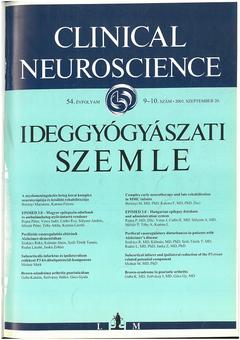The eLitMed.hu medical portal uses computer cookies for convenient operation. Detailed information can be found in the Cookie-policy.
Clinical Neuroscience - 2001;54(09-10)
Content
[Complex early neurotherapy and late rehabilitation in MMC infants ]
[Authors report on the application of their new diagnostic methods in the early diagnosis of somatic and vegetative defects in MMC newborns. A special form ot urodynamics called neuro-urodynamics was developed and applied together with intravesical stimulation of the inactive neurogenic bladder to activate reaction. Paraparetic lower extremities were activated by stimulation of higher motor subcortical control systems through the labyrinths. Authors also report on results obtained by intravesical electrotherapy of the neurogenic bladder, intraluminal electrotherapy of the paralysed rectal sphincter and special extrapyramidal neurotherapy or the affected hip and leg muscles.]
[EPIMED 3.0 - hungarian epilepsy database and administration system ]
[Authors demonstrate the results of their seven-year-long development of the EPIMED 3.0 software applicable in epilepsy outpatient care. Compared to similar programs, EPIMED cantains innovations both from professional and formai aspects. The software records not only strict "epileptological" data of the patients but also registers the psychopathological and social background of the illness. Validation of patient dala is special: the average frequency (in %) of the occurrence of the given event is also recorded. The program also gives the possibility to record the medical activities planned at control visits. lt stresses the role of seizure provoking factors. The main innovation of the program is that despite the fact that all record data originates from pre-caded lists, text on the screen or in printed farm (general recards, medical summaries, examination forms etc.) can be handled as (virtual) free text. The internal search program has unlimited access to coded data and produces all the lists necessary for the monthly demographic and financial statistics reports and all data can be utilized for scientific evaluation. Epimed also contains an automatic AED prescription function. lt is able to demonstrate the longitudinal development of the most important medical data, like the seizure frequency, ADEs, serum levels etc. in graphical mode. Authors summarize the requirements of dala management systems designed for outpatient care. Based on literature dala, the scientific importance of databases originated from these systems is emphasized and the harmonization of databases available already in Hungary is proposed.]
[Peripheral vasoregulatory disturbances in patients with alzheimer's disease]
[Recent data indicate that the autonomic nervous system is affected in Alzheimer's disease (AD). Cutaneous active vasodilatation is a cholinergic nerve mediated function of the sympathetic nervous system and disturbance in the cholinergic neurotransmission plays an important role in the pathogenesis of Alzheimer's disease. Present investigation provides analysis of the autonomic part of the cholinergic system examined by a simple vasodilatory test, the isometric handgrip exercise (IHE). Twenty-two patients with Alzheimer's disease and twenty healthy, age- and sexmatched controls (AC) participated in the study. Skin blood flow, R-wave interval from the electrocardiogram, mean blood pressure, systolic and diastolic blood pressure were monitored. The IHE increased systolic and diastolic blood pressure in both groups, but change in the systolic blood pressure was significantly less in the Alzheimer's disease group than in the AC g roup (AC: 48± 17, AD: 35± 12 Hgmm; p<0,01 ). Significantly decreased skin blood flow and higher cutaneous vascular resistance (AC: 0.08±0.419, AD: 0.32±0.288; p<0.04) were found after the exercise in the Alzheimer's disease group. A reduction of R-wave intervals (AC: -162±94. 9, AD: -108±51.4 ms; p<0.03) to IHE was detected in the Alzheimer's disease patients compared to AC patients. Our results suggest that autonomic dysfunction of the cholinergic vasodilator system as well as an altered sympathovagal tone of cardiac function is present in Alzheimer' s disease.]
[Subcortical infarct and ipsilateral reduction of the P3 event related potential component ]
[The mechanism of generation and the site of origin of P3 event related potential component, related to cognitive processes, is still unknown. Data obtained from humans indicate the probable importance of the temporoparietal junction area: the frontal lobes and limbic structures. ln the patient discussed, the subcortical infarct involved a small region of the lentiform nucleus and posterior part of the internal capsule and caused the conspicuous ipsilateral amplitude reduction of the P3 in the central and temperal regions. This amplitude reduction was probably caused by the involvement of the thalamocortical radiation.]
[Brown-syndrome in psoriatic arthritis ]
[Brown-syndrome is an isolated palsy of the inferior oblique muscle, as a result of the mechanical obstruction of the antagonist superior oblique muscle. The mechanism of the syndrome has remained equivocal. ln a case of vertical diplopia we diagnosed Brown-syndrome, where the patient had a long history of psoriatic arthritis.]
1.
Clinical Neuroscience
[Headache registry in Szeged: Experiences regarding to migraine patients]2.
Clinical Neuroscience
[The new target population of stroke awareness campaign: Kindergarten students ]3.
Clinical Neuroscience
Is there any difference in mortality rates of atrial fibrillation detected before or after ischemic stroke?4.
Clinical Neuroscience
Factors influencing the level of stigma in Parkinson’s disease in western Turkey5.
Clinical Neuroscience
[The effects of demographic and clinical factors on the severity of poststroke aphasia]1.
2.
3.
4.
5.



